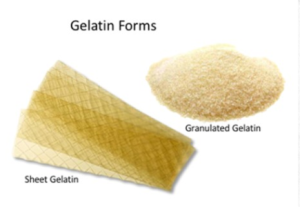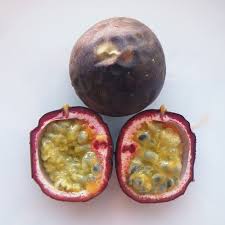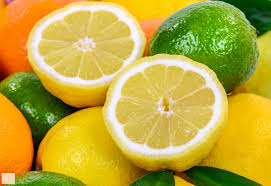6 Chapter 6-A Deep Dive into Gelatin!
Learning Objectives
- A Deep Dive into Gelatin!

Gelatin is considered a hydrocolloid.
While it melts starting at 68 degrees F and sets starting at 86 degrees F, it fully activates/incorporates with liquids at 110 degrees F. This means that when you are melting something that has gelatin as the stabilizer (for example, a glaze), you must melt it past 110 degrees F for the gelatin to fully release. This action will also ensure a lovely shine to your glaze when it re-sets!
Other attractive elements of gelatin are the long setting time (making with working time of your product longer) and the smooth mouthfeel of your products (almost body temperature melting point). It is also inexpensive and easy to access.
Gelatin comes in sheet form or powdered form, and using each one is the preference of the chef.
The strength of gelatin is known as Bloom Strength. Bloom strength refers to how firm a gelatin is once bloomed (hydrated) and then set within a liquid.
Of the various types of gelatin, each type has a different bloom strength and a different weight in grams per sheet:
| Type of Gelatin | Bloom Strength | Weight in Grams per Sheet |
| Platinum Sheets | 235-265 Bloom | 1.7g |
| Gold Sheets | 190-220 Bloom | 2g |
| Silver Sheets | 160 Bloom | 2.5g |
| Bronze Sheets | 125-155 Bloom | 3.3g |
| Powdered Gelatin | 225 Bloom | N/A |
When moving between the different types of gelatin, you can not use a 1:1 ratio by weight because of the different strengths. However, if your formula calls for “sheets” of gelatin, you can swap between the types since they are all formulated to set similarly per “sheet”.
Chef’s Note: Some specific math conversions are done to swap between the different types of gelatin when using weight. This is a bit complex and will be taught to you later in your pastry career here at JWU!
Check out this video for further information on everything gelatin!
How to use Gelatin:
- Bloom (hydrate) the gelatin in cold water.
- For powdered gelatin, use a ratio of 1 part powdered gelatin to 5 parts water.
- For sheet gelatin, plunge the sheets (one by one) into ICE Water.
- Allow the gelatin to hydrate in the water for about 5 minutes.
- For powdered gelatin, you can then use the gelatin mixture as needed in your specific formula.
- For sheet gelatin, squeeze the excess water from the hydrated sheets, then use as needed in your specific formula.
Gelatin and Tropical Fruits:
Certain tropical fruits have an enzyme called protease.
This enzyme will eat the protein in gelatin, therefore, in order to use gelatin with these fruits, you must boil the fruit puree or cook the fruit to kill the enzyme first. Going up to 165 degrees F for 5 minutes is sufficient to kill protease.
Fruits that contain protease are kiwi, fig, pineapple, papaya, and guava. 
Gelatin and Acidic Fruits:
Some fruits are very acidic, and the high levels of acidity weaken the gelatin proteins. When trying to set these fruit juices with gelatin, you will need to INCREASE the gelatin to get the same setting structure you would see with non-acidic fruits. Alcohol also causes gelatin to weaken, so experimentation is needed to ensure your formula will set if there is alcohol within.
Fruits with high acidity are lemon, lime, grapefruit, and passion fruit. 

hydrophilic molecules that are used as functional ingredients in food formulation for increasing food consistency, improving the gelling effect, and controlling the microstructure, texture, flavor, and shelf life.
The measurement by which gelatin setting power is indicated.

